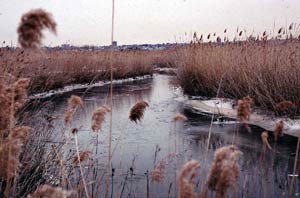The Hackensack Meadowlands: History, Ecology, and Restoration of a Degraded Urban Wetland

Photograph by Erik Kiviat
The Hackensack Meadowlands (also called the Hackensack Meadows or New Jersey Meadowlands), broadly defined, comprise a large area of tidal and nontidal wetlands, wetland fill, and small natural uplands associated with the estuary of the Hackensack River from the Oradell Dam south to Newark Bay. Three centuries ago, the Meadowlands were predominantly a mosaic of Atlantic white cedar swamps, salt marshes, and other wetland and upland habitats. Today they are a system of fragmented and contaminated urban wetlands dotted with dumps, crisscrossed by highways, railroads, pipelines, and dikes, and closely surrounded by dense industrial, commercial, and residential development a few miles from Manhattan. Yet these degraded ecosystems are a magnet for migrant and breeding marsh, water, and shore birds and are inhabited by a moderate diversity of fish and other animals. They are also home to rare plants and have a moderate to high rate of marsh-plant productivity. Moreover, people are increasingly using the Meadowlands for recreation, nature tourism and study, and scientific research.
This issue of Urban Habitats presents seven studies of the Meadowlands and one study of the neighboring Passaic River. These studies range from an examination of the heavy metal molecules contaminating Meadowland marsh sediments to a characterization of the entire Meadowlands region using remote sensing technology. The papers are drawn from recent research presented at the Meadowlands Symposium, a conference held in October 2003 in Lyndhurst, New Jersey. Hosted by the New Jersey Meadowlands Commission and the Meadowlands Research Institute, and cosponsored by the U.S. Fish and Wildlife Service, Hudsonia Ltd., and the U.S. Army Corps of Engineers, this conference was attended by more than 200 researchers, natural resource managers, policy specialists, and graduate students—most of them actively involved in the study or management of the Meadowlands.
The diverse nature of this collection of papers tells us much about the complexity of studying, conserving, and managing the Meadowlands. The data herein, along with other current research, will help us to improve landscape preservation, biological conservation, wetland restoration, and water management in the Meadowlands, as well as in other urban wetlands. Many studies done in the Meadowlands recently and in years past have of necessity focused on one or two sites, a few sampling stations, or small sets of samples (e.g., plots, gill-net collections, bird counts, cores for pollen analysis). But each individual site or sampling station in nature is different, and often dramatically so where both intensive human activity and changing tides and salinity add more variables to already complex landscapes. Studying one or two sites in the Meadowlands is often a good start, but it does not necessarily generate data that are representative of the entire system—or of nearby urban reed-marsh complexes such as the Arthur Kill drainage, Jamaica Bay, or Delaware Bay. Spatial and temporal replication of these studies will help determine which results can be generally applied, and how plants, animals, and ecological processes vary with the seasons, sea-level rise, contamination, salinity, and other environmental factors. Similarly, many studies in the Meadowlands have focused on just a few groups of organisms, not the entire range of species from bacteria to vertebrates, and studies of one group do not necessarily predict the species list and ecological functions of another. Further research spanning a broader spectrum of taxonomic groups is needed.
Several challenges of development and environmental management loom over the Meadowlands: converting inactive landfills to golf courses while maintaining habitat for a broad spectrum of native plants and animals; managing floodwaters to reduce damage to property and infrastructure; controlling mosquitoes to reduce nuisance and the risk of disease; designing, implementing, and maintaining wetland mitigation projects that demonstrably replace wetland functions and values lost to development; and managing and restoring plants, animals, and ecological functions in open-space preserves. The research presented in this issue, as well as other research being conducted in the Meadowlands and in urban wetlands elsewhere, will help us meet some of these challenges and formulate other questions as decisions are made.
Many human societies have evolved and flourished, and some have perished, in wetland regions of the world. Wetlands provide ecosystem services, food, travel routes, refuges, fertile soils, raw materials, and other resources to humans, but they also present risks of flooding, land subsidence, and disease. Wetlands that are misunderstood and mismanaged during the process of development and urbanization may become more hazardous than provident. The Hackensack Meadowlands and other urban wetlands around the world hold the knowledge we need to live in balance with wetland systems, if ever we are able to do so.
Erik Kiviat
Guest Editor
Hudsonia Ltd.
24 December, 2004
